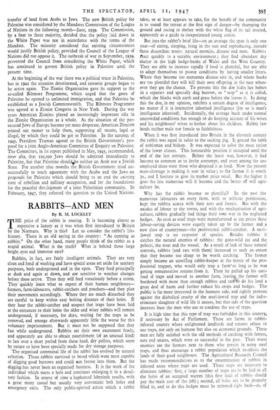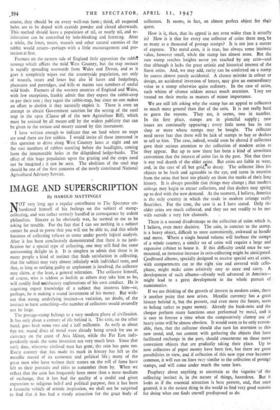RABBITS-AND MEN
By R. M. LOCKLEY
THE price of the rabbit is soaring. It is becoming almost as expensive a luxury as it was when first introduced to Britain by the Normans. Why is this? Let us consider the rabbit's life- history. There is an old saying in the country: "As cunning as rabbits." On the other hand, many people think of the rabbit as a stupid animal. What is the truth? What is behind those large bright eyes and immense ears?
Rabbits, in fact, are fairly intelligent animals. They are very clean and fond of washing and have special areas set aside for sanitary purposes, both underground and in the open. They feed principally at dusk and again at dawn, and. are sensitive to weather changes before these arrive. Thus they will feed voraciously before a storm. They quickly learn what to expect of their human neighbours— farmers, farm-labourers, rabbit-catchers and poachers—and they plan their movements accordingly. Where they are much disturbed they are careful to keep within easy bolting distance of their holes. If they hear the rabbit-catcher and suspect that traps have been laid at the entrances to their holes the older and wiser rabbits will remain underground, if necessary, for days, waiting for the traps to be removed, and emerge afterwards apparently little the worse for this voluntary imprisonment. But it must not be supposed that they fast while underground. Rabbits eat their own excrement freely, and apparently are able to obtain nourishment (of an unusual kind) to last over a short period from these hard, dry pellets, which seem by nature to have been specially made for dry storage purposes.
The organised communal life of the rabbit has evolved by natural selection: Those rabbits survived to breed which were most capable of digging good burrows and could iiun fastest into them. But the digging.has never been an organised business. It is the work of the individual which starts a hole and continues enlarging it in a desul- tory fashion. In course of time a haphazard labyrinth results, with a great many casual but usually very convenient bolt holes and emergency exits. The only public-spirited action which a rabbit takes, or at least appears to take, for the benefit of the community is to sound the retreat at the first sign of danger—by thumping the ground and racing to shelter with the white flag of its tail erected, apparently as a guide to inexperienced young conies.
But into the rabbit's brief life—on an average the span is only one year—of eating, sleeping, lying in the sun and reproducing, intrude three discordant notes : natural enemies, disease and man. Rabbits &act quickly to a suitable environment ; they find abundant dry shelter in the high hedge-banks of Wales and the West Country. They are able to increase rapidly if food is plentiful, but are able to adapt themselves to poorer conditions by having smaller litters. Where they become too numerous disease sets in, and where bucks are too plentiful they will kill their own offspring in the nest when- ever they get the chance. To prevent this the doe hides her babies in a separate and specially dug burrow, or " stop " as it is called, which she blocks with earth and grass before she leaves it. In doing this the doe, in my opinion, exhibits a certain degree of intelligence, no matter if it is instinctive inherited intelligence (for so is man's intelligence inherited). Incidentally, the average buck under normal uncrowded conditions has enough td do keeping account of his wives and his neighbours' wives to bother about his children. Rabbit law binds neither male nor female to faithfulness.
When it was first introduced into Britain in the eleventh century the rabbit was equal in value to the sucking pig. It graced the table of nobleman and bishop. It was expected to solve the meat ration of the lower classes. This honourable position it occupied until the end of the last century. Before the latest war, however, it had become so common as to invite contempt, and even among the un- employed there were those who despised it as food. Now the present meat-shortage is making it soar in value ; to the farmer it is worth 3s., and I hesitate to give its market price retail. But the higher it goes the less numerous will it become and the better off will agri- culture be.
Why has the rabbit become so plentiful? In the past the numerous labourers on every farm, with or without permission, kept the rabbits scarce with their nets and ferrets. But with the exodus of labour to the towns, and with the mechanisation of agri- culture, rabbits gradually had things their own way in the neglected hedges. As soon as steel traps were manufactured at cut prices these labour-saving devices were eagerly taken up by the farmer and a new class of countryman—the professional rabbit-catcher. A steel- jawed trap is no respecter of species. Besides rabbits it catches the natural enemies of rabbits: the gone-wild cat and the polecat, the stoat and the weasel. As a result of lack of these natural controls, rabbits (and rats with them) increased to such an extent that they became too cheap to be worth catching. The farmer simply became an unwilling rabbit-keeper at the mercy of the pro- fessional trapper, who would only trap a farm9so long as he was getting remunerative returns from it. Then he pulled up his cart- load of traps and moved to another farm, leaving_the farmer still burdened with more than enough rabbits and rat#166 do his land a great deal of harm and further reduce his crops and hedges. The public is far more interested in the humane side, and rightly protests against the diabolical cruelty of the steel-jawed trap and the indis- criminate slaughter of wild life it causes, but that side of the question interests least the men who use or condone the use of traps.
It is high time that this type of trap was forbidden in this country, if necessary by Act of Parliament. There are farms in rabbit- infested country where enlightened landlords and tenants refuse to use traps, not only on humane but also on economic grounds. These men are fully satisfied with the old methods of catching with ferrets, nets and snares, which were so successful in the past. Their worst enemies are the farmers next to them who persist in using steel traps, and thus encourage a rabbit population which re-infests the lands of their good neighbours. The Agricultural Research Council has made recommendations as to the extermination of rabbits in infested areas where traps are used. Three steps are necessary to eliminate rabbits : first, a large number of traps are to be laid in all the holes of an occupied warren (this first haul of rabbits should pay the main cost of the job) ; second, all holes are to be properly filled in, and to do this hedges must be trimmed right back—as, of course, they should be on every well-run farm ; third, all reopened holes are to be doped with cyanide powder and closed afterwards.
This method should leave a population of nil, or nearly nil, and re- infestation can be controlled by hole-blocking and ferreting. After a while, the foxes, stoats, weasels and other natural enemies of the rabbit would return—perhaps with a little encouragement and pro- tection at first.
Farmers on the eastern side of England little appreciate the rabbit scourge which afflicts the mild West Country, but the trap menace is rapidly spreading eastwards from Wales and Devon, and as it goes it completely wipes out the countryside population, not only of weasels, stoats and foxes but also 'of hares and hedgehogs, pheasants and partridges, and kills or maims vast numbers of useful wild birds. Farmers of the western counties of England and Wales, with few exceptions, frankly admit that they expect the rabbit-crop to pay their rent ; they regret the rabbit-trap, but since no one makes an effort to abolish it they naturally exploit it. There is even an attempt to obtain Government sanction for the setting of the steel trap in the open (Clause 98 of the new Agriculture Bill), which must be resisted by all means anti by the widest publicity that can be given to the torture and misery caused by this instrument.
I have written enough to indicate that on land where no traps are used there are few rabbits. I would invite all those interested in this question to drive along West Country lanes at night and see the vast numbers of rabbits scuttling before the headlights, coming from the innumerable holes in the dilapidated hedge-banks. The effect of this huge population upon the grazing and the crops need not be imagined ; it can be seen. The abolition of the steel trap should be one of the first concerns of the newly constituted National Agricultural Advisory Service.



































 Previous page
Previous page